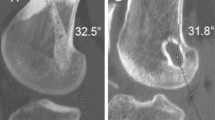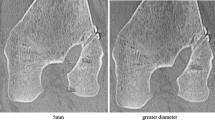Abstract
Purpose
It is proposed that central femoral ACL graft placement better controls rotational stability. This study evaluates the consequence of changing the femoral tunnel position from the AM position drilled transtibially to the central position drilled transportally. The difference in ACL graft failure is reported.
Methods
This prospective consecutive patient single surgeon study compares the revision rates of 1016 transtibial hamstring ACL reconstructions followed for 6–15 years with 464 transportal hamstring ACL reconstructions followed for 2–6 years. Sex, age, graft size, time to surgery, meniscal repair and meniscectomy data were evaluated as contributing factors for ACL graft failure to enable a multivariate analysis. To adjust for the variable follow-up a multivariate hazard ratio, failure per 100 graft years and Kaplan–Meier survivorship was determined.
Results
With transtibial ACLR 52/1016 failed (5.1%). With transportal ACLR 32/464 failed (6.9%). Significant differences between transportal and transtibial ACLR were seen for graft diameter, time to surgery, medial meniscal repair rates and meniscal tissue remaining after meniscectomy. Adjusting for these the multivariate hazard ratio was 2.3 times higher in the transportal group (p = 0.001). Central tunnel placement resulted in a significantly 3.5 times higher revision rate compared to an anteromedial tunnel placement per 100 graft years (p = 0.001). Five year survival was 980/1016 (96.5%) for transtibial versus 119/131 (90.5%) for transportal. Transportal ACLR also showed a significantly higher earlier failure rate with 20/32 (61%) of the transportal failing in the first year compared with 14/52 (27%) for transtibial. (p = 0.001.)
Conclusion
Transportal central femoral tunnel ACLR has a higher failure rate and earlier failure than transtibial AM femoral tunnel ACLR.
Level of evidence
Level II—prospective comparative study.


Similar content being viewed by others
References
Artmann M, Wirth CJ (1974) Investigation of the appropriate functional replacement of the anterior cruciate ligament (author’s transl). Z Orthop Ihre Grenzgeb 112:160–165
Bedi A, Musahl V, Steuber V, Kendoff D, Choi D, Allen AA et al (2011) Transtibial versus anteromedial portal reaming in anterior cruciate ligament reconstruction: an anatomic and biomechanical evaluation of surgical technique. Arthroscopy 27:380–390
Beynnon BD, Uh BS, Johnson RJ, Fleming BC, Renstrom PA, Nichols CE (2001) The elongation behavior of the anterior cruciate ligament graft in vivo. A long-term follow-up study. Am J Sports Med 29:161–166
Chu CR, Williams AA, West RV, Qian Y, Fu FH, Do BH et al (2014) Quantitative magnetic resonance imaging UTE-T2* mapping of cartilage and meniscus healing after anatomic anterior cruciate ligament reconstruction. Am J Sports Med 42:1847–1856
Cross MB, Musahl V, Bedi A, O’Loughlin P, Hammoud S, Suero E et al (2012) Anteromedial versus central single-bundle graft position: which anatomic graft position to choose? Knee Surg Sports Traumatol Arthrosc 20:1276–1281
Debandi A, Maeyama A, Lu S, Hume C, Asai S, Goto B et al (2011) Biomechanical comparison of three anatomic ACL reconstructions in a porcine model. Knee Surg Sports Traumatol Arthrosc 19:728–735
Driscoll MD, Isabell GP Jr, Conditt MA, Ismaily SK, Jupiter DC, Noble PC et al (2012) Comparison of 2 femoral tunnel locations in anatomic single-bundle anterior cruciate ligament reconstruction: a biomechanical study. Arthroscopy 28:1481–1489
Duffee A, Magnussen RA, Pedroza AD, Flanigan DC, Kaeding CC (2013) Transtibial ACL femoral tunnel preparation increases odds of repeat ipsilateral knee surgery. J Bone Joint Surg Am 95:2035–2042
Friederich N (1993) Knee joint function and the cruciate ligaments. Biomechanical principles for reconstruction and rehabilitation. Der Orthopäde 22(6):334–342
Fu FH, Jordan SS (2007) The lateral intercondylar ridge—a key to anatomic anterior cruciate ligament reconstruction. J Bone Joint Surg Am 89:2103–2104
Fu FH, van Eck CF, Tashman S, Irrgang JJ, Moreland MS (2015) Anatomic anterior cruciate ligament reconstruction: a changing paradigm. Knee Surg Sports Traumatol Arthrosc 23:640–648
Hefzy MS, Grood ES, Noyes FR (1989) Factors affecting the region of most isometric femoral attachments. Part II: the anterior cruciate ligament. Am J Sports Med 17:208–216
Iwahashi T, Shino K, Nakata K, Otsubo H, Suzuki T, Amano H et al (2010) Direct anterior cruciate ligament insertion to the femur assessed by histology and 3-dimensional volume-rendered computed tomography. Arthroscopy 26:S13–S20
Kawaguchi Y, Kondo E, Takeda R, Akita K, Yasuda K, Amis AA (2015) The role of fibers in the femoral attachment of the anterior cruciate ligament in resisting tibial displacement. Arthroscopy 31:435–444
Kondo E, Merican AM, Yasuda K, Amis AA (2011) Biomechanical comparison of anatomic double-bundle, anatomic single-bundle, and nonanatomic single-bundle anterior cruciate ligament reconstructions. Am J Sports Med 39:279–288
Lim HC, Yoon YC, Wang JH, Bae JH (2012) Anatomical versus non-anatomical single bundle anterior cruciate ligament reconstruction: a cadaveric study of comparison of knee stability. Clin Orthop Surg 4:249–255
Loh JC, Fukuda Y, Tsuda E, Steadman RJ, Fu FH, Woo SL (2003) Knee stability and graft function following anterior cruciate ligament reconstruction: comparison between 11 o’clock and 10 o’clock femoral tunnel placement. 2002 Richard O’Connor Award paper. Arthroscopy 19:297–304
Lubowitz JH (2014) Anatomic ACL reconstruction produces greater graft length change during knee range-of-motion than transtibial technique. Knee Surg Sports Traumatol Arthrosc 22:1190–1195
Markolf KL, Jackson SR, McAllister DR (2010) A comparison of 11 o’clock versus oblique femoral tunnels in the anterior cruciate ligament-reconstructed knee: knee kinematics during a simulated pivot test. Am J Sports Med 38:912–917
Markolf KL, Park S, Jackson SR, McAllister DR (2009) Anterior-posterior and rotatory stability of single and double-bundle anterior cruciate ligament reconstructions. J Bone Joint Surg Am 91:107–118
Markolf KL, Park S, Jackson SR, McAllister DR (2008) Contributions of the posterolateral bundle of the anterior cruciate ligament to anterior-posterior knee laxity and ligament forces. Arthroscopy 24:805–809
Mochizuki T, Fujishiro H, Nimura A, Mahakkanukrauh P, Yasuda K, Muneta T et al (2014) Anatomic and histologic analysis of the mid-substance and fan-like extension fibres of the anterior cruciate ligament during knee motion, with special reference to the femoral attachment. Knee Surg Sports Traumatol Arthrosc 22:336–344
Musahl V, Plakseychuk A, VanScyoc A, Sasaki T, Debski RE, McMahon PJ et al (2005) Varying femoral tunnels between the anatomical footprint and isometric positions: effect on kinematics of the anterior cruciate ligament-reconstructed knee. Am J Sports Med 33:712–718
Nawabi DH, Tucker S, Schafer KA, Zuiderbaan HA, Nguyen JT, Wickiewicz TL et al (2016) ACL fibers near the lateral intercondylar ridge are the most load bearing during stability examinations and isometric through passive flexion. Am J Sports Med 44:2563–2571
Okafor EC, Utturkar GM, Widmyer MR, Abebe ES, Collins AT, Taylor DC et al (2014) The effects of femoral graft placement on cartilage thickness after anterior cruciate ligament reconstruction. J Biomech 47:96–101
Pathare NP, Nicholas SJ, Colbrunn R, McHugh MP (2014) Kinematic analysis of the indirect femoral insertion of the anterior cruciate ligament: implications for anatomic femoral tunnel placement. Arthroscopy 30:1430–1438
Pearle AD, Shannon FJ, Granchi C, Wickiewicz TL, Warren RF (2008) Comparison of 3-dimensional obliquity and anisometric characteristics of anterior cruciate ligament graft positions using surgical navigation. Am J Sports Med 36:1534–1541
Rahr-Wagner L, Thillemann TM, Pedersen AB, Lind MC (2013) Increased risk of revision after anteromedial compared with transtibial drilling of the femoral tunnel during primary anterior cruciate ligament reconstruction: results from the Danish Knee Ligament Reconstruction Register. Arthroscopy 29:98–105
Siebold R, Schuhmacher P, Fernandez F, Smigielski R, Fink C, Brehmer A et al (2014) Flat midsubstance of the anterior cruciate ligament with tibial “C"-shaped insertion site. Knee Surg Sports Traumatol Arthrosc 2015 Nov;23(11):3136–3142
Smigielski R, Zdanowicz U, Drwiega M, Ciszek B, Ciszkowska-Lyson B, Siebold R (2014) Ribbon like appearance of the midsubstance fibres of the anterior cruciate ligament close to its femoral insertion site: a cadaveric study including 111 knees. Knee Surg Sports Traumatol Arthrosc 23(11):3143–3150
Smigielski R, Zdanowicz U, Drwiega M, Ciszek B, Williams A (2016) The anatomy of the anterior cruciate ligament and its relevance to the technique of reconstruction. Bone Joint J 98-B:1020–1026
Funding
No external source of funding was used.
Author information
Authors and Affiliations
Contributions
MC performed all the surgery and followed all the patients. He was involved in patient evaluation and statistical evaluation. He edited the final manuscript. He agrees to be accountable for all aspects of the work in ensuring that questions related to the accuracy or integrity of any part of the work are appropriately investigated and resolved. SS reviewed the results and statistical analysis and wrote the manuscript. TR collected all the revision’s from MC’s database. He reviewed patient clinical records on all 1480 patients to ensure the data was accurate and was involved in the statistical analysis.
Corresponding author
Ethics declarations
Conflict of Interest
Mark Clatworthy receives consulting fees from Johnson and Johnson and fellowship support from Johnson and Johnson and Athrex and royalties from Athrex Steffen Sauer and Tim Roberts have no conflict of interest.
Ethical approval
All procedures performed in studies involving human participants were in accordance with the ethical standards of the institutional and/or national research committee and with the 1964 Helsinki declaration and its later amendments or comparable ethical standards.
Rights and permissions
About this article
Cite this article
Clatworthy, M., Sauer, S. & Roberts, T. Transportal central femoral tunnel placement has a significantly higher revision rate than transtibial AM femoral tunnel placement in hamstring ACL reconstruction. Knee Surg Sports Traumatol Arthrosc 27, 124–129 (2019). https://doi.org/10.1007/s00167-018-5036-x
Received:
Accepted:
Published:
Issue Date:
DOI: https://doi.org/10.1007/s00167-018-5036-x




